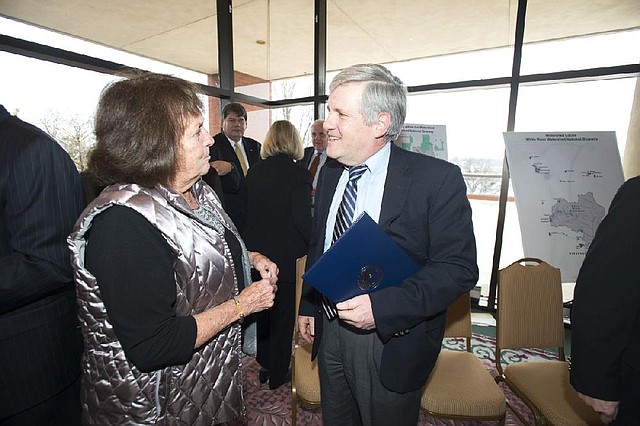White River named Blueway
National designation recognizes conservation efforts
Alice Andrews with the Ozark Society talks with David J. Hayes, Deputy Secretary of the Interior following an announcement that named the White River, along with its watershed, as being designated the nation’s second National Blueway on Wednesday afternoon at the Peabody Hotel. National Blueways are nationally recognized rivers and their watersheds that are highly-valued recreational, social, economic, cultural, and ecological assets for the communities that depend on them.
Thursday, January 10, 2013
LITTLE ROCK — Representatives of several federal agencies met Wednesday in Little Rock to name the White River and its watershed the country’s second National Blueway and to announce a series of federal efforts to preserve the quality of the river and to protect surrounding soil and wildlife.
The Blueway designation was created by President Barack Obama’s administration to recognize river-conservation work among local groups and to encourage cooperation among federal agencies to assist in those efforts.
“This river and watershed sings when it comes to partnering of all kinds,” Deputy Secretary of the Interior David Hayes told a group of riv-er advocates gathered at the Peabody Little Rock hotel.
Hayes called the new designation “a challenge” to federal agencies “to coordinate with you and to serve you.”
The designation does not establish a new protective status or regulation, and it does not guarantee any new federal funding.
Rivers are named National Blueways after selection by a national interagency committee appointed by the secretary of the interior that includes representatives from the Fish and Wildlife Service, the National Park Service and the U.S. Department of Agriculture, Hayes said.
Representatives from those groups announced new conservation efforts around the White River that coincide with its new title Wednesday, including $22 million from the Agriculture Department for soil and water conservation in counties along its watershed.
About $13 million of those funds will support pastureland affected heavily by the 2012 drought, Deputy Secretary of Agriculture Ann Mills said.
“Agriculture is very much at the heart of this watershed,” she said.
The U.S. Fish and Wildlife Service also announced a recently approved 101,000-acre expansion of the Cache River National Wildlife Refuge - named for one of the White River’s main tributaries - that will build habitats througheasements and land acquisition from “willing landowners,” agency representatives said.
That expansion dovetails with plans by the U.S. Army Corps of Engineers to complete the Lower Cache RiverBasin Restoration Project, which will restore the river’s natural meanders in areas where the flow was cut off by flood-control work.
U.S. Rep. Tim Griffin, RArk., called the Blueway initiative “an example of the federal government being led by local folks.”
“You are making sure the White River will remain a great resource for my 2-yearold and 5-year-old for decades to come,” he said.
U.S. Sen. Mark Pryor, DArk., applauded local groups for gaining national notice for their efforts.
“You’re the ones who deserve all of the credit for this,” he said.
The White River flows for more than 700 miles from its headwaters in the Ozarks to its mouth at the Mississippi River. Its watershed spans nearly 18 million acres across 60 counties in Arkansas and Missouri.
Public and private landowners in the watershed already have conserved more than 3.2 million acres of their land for the benefit of people and wildlife, the Department of the Interior said.
The river was selected as a National Blueway based on an application submitted by 26 groups, including the Nature Conservancy, Ducks Unlimited, the Arkansas Natural Heritage Commission, the cities of Augusta and Clarendon, and the Lower Mississippi Valley Joint Venture.
The Interior Department first awarded the Blueways designation to the Connecticut River in New England, and it plans to add watersheds in the future.
After the designation, interested parties will form a new committee to monitor work on the river and encourage future efforts.
Arkansas, Pages 7 on 01/10/2013
